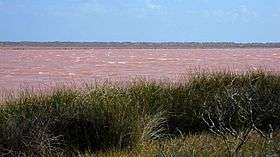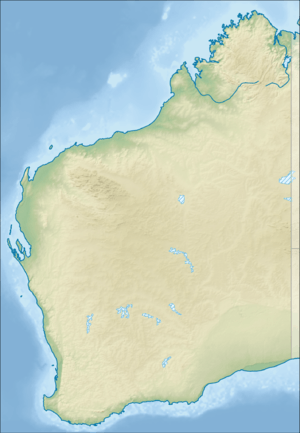Hutt Lagoon
Hutt Lagoon is a marine salt lake located near the Indian Ocean coast 2 kilometres (1.2 mi) north of the mouth of the Hutt River, in the Mid West region of Western Australia.
| Hutt Lagoon | |
|---|---|
 View of Hutt Lagoon from south east shore | |
 Hutt Lagoon Location in Western Australia | |
| Location | Mid Western Australia |
| Coordinates | 28°08′S 114°13′E[1] |
| Type | Marine lake |
| Basin countries | Australia |
| Max. length | 14 km (8.7 mi) |
| Max. width | 2.3 km (1.4 mi) |
| Max. depth | 0.65 m (2 ft 2 in) |
| Surface elevation | below sea-level |
| References | [2] |
Geography
Hutt Lagoon is an elongate lake that sits in a dune swale adjacent to the coast. The town of Gregory is located between the ocean and the lake's southern shores. The road between Northampton and Kalbarri, George Grey Drive, runs along its eastern edge.[3]
The lake is about 14 km (9 mi) in length along its northwest-southeast axis, parallel with the coast, and around 2.3 km (1.4 mi) wide.
Hutt Lagoon comprises most of the Hutt Lagoon System, a DIWA-listed wetland system that also takes in a number of adjacent small lakes, such as Utcha Swamp.[4]
Hydrology
The lagoon, a marginal-marine salina or marine lake, is an elongate depression about 70 square kilometres (27 sq mi) in area, with most of it lying a few metres below sea level. It is separated from the Indian Ocean by a beach barrier ridge and barrier dune system. Similar to Lake MacLeod, 40 kilometres (25 mi) to the north of Carnarvon, Hutt Lagoon is fed by marine waters through the barrier ridge and by meteoric waters through springs.[2]
Due to the salina’s sub-sealevel position, seepage of seawater into the salina is continuous year round. During the winter wet season, the amount of water coming into the salina is substantially increased by the influx of meteoric groundwater. Hutt Lagoon has a Mediterranean climate, with mean annual rainfall of 449 mm (17.7 in) (mainly May to August), and a mean annual evaporation rate of 2,445 mm (96.3 in).[5] These factors combine to form a setting within which salt is deposited seasonally and the rates and style of precipitation follow a balance between influx of water and removal by evaporation. During the summer about 95% of the salina surface is a dry salt flat.[2]
History
Hutt Lagoon was named by the explorer George Grey who camped on its eastern edge on 4 April 1839, while on his second disastrous expedition along the Western Australian coast. He mistook the wet season lagoon for a large estuary and named "the river and estuary now discovered" after William Hutt, M.P., brother of John Hutt, the second Governor of Western Australia. Hutt was a British Liberal politician who was heavily involved in the colonization of Western Australia, New Zealand and South Australia.[6]
After Grey's arrival back in Perth, Governor Hutt dispatched the colonial schooner Champion under Captain Dring to investigate the large estuary and river discovered. In summer, January 1840, George Fletcher Moore aboard Champion reported the Hutt River at its mouth to be dry, and could not locate the large estuary described by Grey.[6][7]
Resources
ß-carotene
Hutt Lagoon is a pink lake, a salt lake with a red or pink hue due to the presence of the carotenoid-producing algae Dunaliella salina, a source of ß-carotene, a food-colouring agent and source of vitamin A. The lagoon contains the world's largest microalgae production plant, a 250-hectare (620-acre) series of artificial ponds used to farm Dunaliella salina.[2]
Brine shrimp
Hutt Lagoon provides a commercial supply of Artemia parthenogenetica brine shrimp. Artemia is a specialty feed used by prawn and fish farmers and the aquarium fish trade.[2]
Salt and gypsum
In 1854 the explorer Augustus Charles Gregory promoted the quantity and quality of the salt deposits at Hutt Lagoon and their proximity to Port Gregory. He also commended the gypsum deposits on the western shore of the lagoon.[8]
At the 1873 Sydney Intercolonial Exhibition salt from the Hutt Lagoon deposit was Highly Commended. Hutt Lagoon gypsum received a Bronze Medal.[9] Hutt Lagoon salt was also exhibited at the 1880 Melbourne Exhibition.[10]
In August 1908 Port Gregory Saltworks consigned its first shipment of salt on SS Venus.[11] Production was seasonal, of the order of 4,000 tons per year and employing up to 50, until the salt operation went into liquidation in 1924.[12]
References
- "Hutt Lagoon". Gazetteer of Australia online. Geoscience Australia, Australian Government.
- Handford, C . Robertson (1991). "Marginal Marine Halite: Sabkas and Salinas". In Judith L. Melvin (ed.). Evaporites, Petroleum and Mineral Resources. Developments in Sedimentology. 50. Amsterdam: Elsevier. pp. 47–49. ISBN 0-444-88680-X. Retrieved 23 July 2012.
- StreetSmart Travellers Atlas of Western Australia (2002)
- "Hutt Lagoon System". Australian Wetlands Database. Department of the Environment and Water Resources, Australian Government.
- Nowick, Anna; Pinder, Adrian; Kern, Stephen; Daniel, Glen (2009). Resource Condition Report for a Significant Western Australian Wetland: Hutt Lagoon (PDF). Bentley, WA: Department of Environment and Conservation. p. 5. Retrieved 2 June 2020.
- Grey, George (1841). Journals of two expeditions of discovery in North-West and Western Australia, during the years 1837, 38, and 39, describing many newly discovered, important, and fertile districts, with observations on the moral and physical condition of the aboriginal inhabitants, etc. etc. 2. London: T. and W. Boone. Retrieved 17 March 2012.
- "Return of the "Champion"". The Perth Gazette and Western Australian Journal. 1 February 1840. p. 19. Retrieved 2 June 2020.
- Gregory, A.C. (17 March 1854). "Report of Mineral Specimens found in the Murchison District". The Perth Gazette and Independent Journal of Politics and News. Retrieved 23 July 2012.
- "Sydney Intercolonial Exhibition". The Inquirer and Commercial News. 4 June 1873. p. 3. Retrieved 23 July 2012.
- "The Melbourne Exhibition". The West Australian. 15 October 1880. p. 3. Retrieved 23 July 2012.
- "Local News". Geraldton Guardian. 11 August 1908. p. 2. Retrieved 23 July 2012.
- "Northampton Notes". Geraldton Guardian. 8 April 1924. p. 2. Retrieved 23 July 2012.
